

| Pre-1600 | Master Index | 1700's |
Chronology of Aviation History for the 1600's
1600-1699 Major Aviation Events
1600-1609
- No data
1610-1619
- No data
1620-1629
- No data
1600-1609
- No data
1630-1639
1630 (Istanbul) — Evliya Çelebi reports, that Hezarfen Ahmet Celebi glided with artificial wings from the top of Galata Tower in Istanbul and managed to fly over the Bosphorus, landing successfully on the Dogancilar Square in Üsküdar.
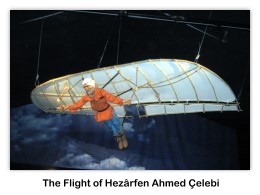 Hezârfen Ahmed Çelebi was a legendary Ottoman aviator of 17th-century Constantinople/Istanbul, purported to have achieved sustained unpowered flight. The 17th century
writings of Evliyâ Çelebi relate this story of Hezârfen Ahmed Çelebi, circa 1630-1632: “First he practiced by flying over the pulpit of Okmeydani eight or nine times with eagle wings, using the force of the wind. Then, as Sultan Murad Khan (Murad IV) was watching from the Sinan Pasha mansion at Sarayburnu, he flew from the very top of the Galata Tower and landed in the Dogancilar square in Üsküdar, with the help of the south-west wind. Then Murad Khan granted him a sack of golden coins, and said: ‘This is a scary man. He is capable of doing anything he wishes. It is not right to keep such people,’ and thus sent him to Algeria on exile. He died there”. [2,4,5]
Hezârfen Ahmed Çelebi was a legendary Ottoman aviator of 17th-century Constantinople/Istanbul, purported to have achieved sustained unpowered flight. The 17th century
writings of Evliyâ Çelebi relate this story of Hezârfen Ahmed Çelebi, circa 1630-1632: “First he practiced by flying over the pulpit of Okmeydani eight or nine times with eagle wings, using the force of the wind. Then, as Sultan Murad Khan (Murad IV) was watching from the Sinan Pasha mansion at Sarayburnu, he flew from the very top of the Galata Tower and landed in the Dogancilar square in Üsküdar, with the help of the south-west wind. Then Murad Khan granted him a sack of golden coins, and said: ‘This is a scary man. He is capable of doing anything he wishes. It is not right to keep such people,’ and thus sent him to Algeria on exile. He died there”. [2,4,5]1633 (Istanbul) — Evliya Çelebi reports, that Lagari Hagen Çelebi flew himself in a rocket artificially-powered by gunpowder.
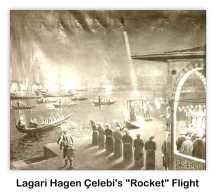 Lagari Hasan Çelebi was a legendary Ottoman Turk who, according to an account written by Evliya Çelebi, made a successful manned rocket flight. Evliya Çelebi proported that in 1633 Lagari Hasan Çelebi was launched in a seven-winged rocket using 140 lbs of gunpowder from Sarayburnu, the point below Topkapi Palace in Istanbul. The flight was said to be undertaken at the time of the birth of Sultan Murad IV's daughter. As Evliya Çelebi wrote, Lagari proclaimed before launch “O my sultan! Be blessed, I am going to talk to Jesus.” After ascending in the rocket, he landed in the sea, swimming ashore and reporting “O my sultan! Jesus sends his regards to you!” He was rewarded by the Sultan with silver and the rank of Sipahi in the Ottoman Army. Evliya Çelebi also wrote of Lagari's brother, Hezârfen Ahmet Çelebi, making a flight by glider a year earlier.
Lagari Hasan Çelebi was a legendary Ottoman Turk who, according to an account written by Evliya Çelebi, made a successful manned rocket flight. Evliya Çelebi proported that in 1633 Lagari Hasan Çelebi was launched in a seven-winged rocket using 140 lbs of gunpowder from Sarayburnu, the point below Topkapi Palace in Istanbul. The flight was said to be undertaken at the time of the birth of Sultan Murad IV's daughter. As Evliya Çelebi wrote, Lagari proclaimed before launch “O my sultan! Be blessed, I am going to talk to Jesus.” After ascending in the rocket, he landed in the sea, swimming ashore and reporting “O my sultan! Jesus sends his regards to you!” He was rewarded by the Sultan with silver and the rank of Sipahi in the Ottoman Army. Evliya Çelebi also wrote of Lagari's brother, Hezârfen Ahmet Çelebi, making a flight by glider a year earlier.In popular culture, the movie Istanbul Beneath My Wings is a film about the lives of Hezârfen Ahmet Çelebi, his brother Lagari Hasan Çelebi, and Ottoman society in the early 17th century as witnessed and narrated by Evliya Çelebi. This legend was tested and debunked on the TV show Myth Busters, on November 11, 2009, in the episode “Crash and Burn.” However, the rocket displayed on the TV show did not adhere to the specifications described by Evliya Çelebi. [2,4,6]
1638 (London, England) — John Wilkins Bishop of Chester, publishes The Discovery of a World in the Moone, in which he reviews ideas about flight and makes a number of suggestions for future trials.
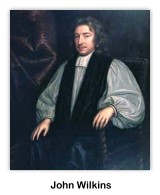 John Wilkins FRS (1 January 1614-19 November 1672) was an English clergyman, natural philosopher and author, as well as a founder of the Royal Society, and Bishop of Chester from 1668 until his death. Wilkins is one of the few persons to have headed a college at both the University of Oxford and the University of Cambridge. He was a polymath, although not one of the most important scientific innovators of the period. His personal qualities were brought out, and obvious to his contemporaries, in reducing political tension in Interregnum Oxford, in founding the Royal Society on non-partisan lines, and in efforts to reach out to religious nonconformists. He was one of the founders of the new natural theology compatible with the science of the time. He is particularly known for An Essay towards a Real Character and a Philosophical Language in which, amongst other things, he proposed a universal language and a decimal system of measure not unlike the modern metric system. [1,2,7]
John Wilkins FRS (1 January 1614-19 November 1672) was an English clergyman, natural philosopher and author, as well as a founder of the Royal Society, and Bishop of Chester from 1668 until his death. Wilkins is one of the few persons to have headed a college at both the University of Oxford and the University of Cambridge. He was a polymath, although not one of the most important scientific innovators of the period. His personal qualities were brought out, and obvious to his contemporaries, in reducing political tension in Interregnum Oxford, in founding the Royal Society on non-partisan lines, and in efforts to reach out to religious nonconformists. He was one of the founders of the new natural theology compatible with the science of the time. He is particularly known for An Essay towards a Real Character and a Philosophical Language in which, amongst other things, he proposed a universal language and a decimal system of measure not unlike the modern metric system. [1,2,7]1638 (Hereford, England) — Geese haul fictional flyer up to the Moon — Bishop Francis Godwin's fictional book Man in the Moone has been published. It describes a fantastic journey to the Moon by Spaniard Domingo Gonsales.
 But the work has little, if any, basis in scientific deduction about flight.
But the work has little, if any, basis in scientific deduction about flight.Godwin's hero tamed a flock of wild swans which he called gansas, which he trained to carry burdens. By connecting each bird to a single large carrying structure, Gonsales could be raised up. To prevent this gondola from being unsteadied by birds taking off at different times, and each was tethered by string and pulley, which let out extra string to the lead birds until all were airborne.
To Gonsales's surprise, the gansas flew to the Moon for winter. On a twelve-day flight, he observed the daily rotation of the Earth and the Moon's mighty seas and mountains. The return trip took nine days, quicker than the outward flight because of the Earth's gravity. [1,8] (One small step for Gonsales, one giant leap for Godwin!)
1640-1649
1644 (Italy) — Italian physicist Evangelista Torricelli manages to demonstrate atmospheric pressure, and also produces a vacuum. Evangelista Torricelli (October 15, 1608 - October 25, 1647) was an Italian physicist and mathematician, best known for his invention of the barometer.
 Evangelista Torricelli was born in Faenza, part of the Papal States. He was left fatherless at an early age and educated under the care of his uncle, a Camaldolese monk, who first entered young Torricelli into a Jesuit College in 1624 to study mathematics and philosophy until 1626, when he sent Torricelli to Rome in 1627 to study science under the Benedictine Benedetto Castelli, professor of mathematics at the Collegio della Sapienza in Pisa. In 1632, shortly after the publication of Galileo's Dialogues of the New Science, Torricelli wrote to Galileo of reading it “with the delight [...] of one who, having already practiced all of geometry most diligently [...] and having studied Ptolemy and seen almost everything of Tycho Brahe, Kepler and Longomontanus, finally, forced by the many congruences, came to adhere to Copernicus, and was a Galileian in profession and sect.” The Vatican condemned Galileo in June 1633, and this was the only known occasion on which Torricelli openly declared himself to hold the Copernican view.
Evangelista Torricelli was born in Faenza, part of the Papal States. He was left fatherless at an early age and educated under the care of his uncle, a Camaldolese monk, who first entered young Torricelli into a Jesuit College in 1624 to study mathematics and philosophy until 1626, when he sent Torricelli to Rome in 1627 to study science under the Benedictine Benedetto Castelli, professor of mathematics at the Collegio della Sapienza in Pisa. In 1632, shortly after the publication of Galileo's Dialogues of the New Science, Torricelli wrote to Galileo of reading it “with the delight [...] of one who, having already practiced all of geometry most diligently [...] and having studied Ptolemy and seen almost everything of Tycho Brahe, Kepler and Longomontanus, finally, forced by the many congruences, came to adhere to Copernicus, and was a Galileian in profession and sect.” The Vatican condemned Galileo in June 1633, and this was the only known occasion on which Torricelli openly declared himself to hold the Copernican view.Aside from several letters, little is known of Torricelli's activities in the years between 1632 and 1641, when Castelli sent Torricelli's monograph of the path of projectiles to Galileo, then a prisoner in his villa at Arcetri. Although Galileo promptly invited Torricelli to visit, he did not accept until just three months before Galileo's death. During his stay, however, he wrote out Galileo's Discourse of the Fifth day. After Galileo's death on January 8, 1642, Grand Duke Ferdinando II de'Medici asked him to succeed Galileo as the grand-ducal mathematician and professor of mathematics in the University of Pisa. In this role he solved some of the great mathematical problems of the day, such as finding a cycloid's area and center of gravity.
He also designed and built a number of telescopes and simple microscopes. Several large lenses, engraved with his name, are still preserved at Florence. In 1644, he famously wrote in a letter: “We live submerged at the bottom of an ocean of air.” Torricelli died in Florence a few days after having contracted typhoid fever, and was buried in San Lorenzo. The asteroid 7437 Torricelli was named in his honor. He left all his belongings to his adopted son Alexander.
Torricelli's chief invention was the mercury barometer, which arose from solving a practical problem. Pump makers of the Grand Duke of Tuscany attempted to raise water to a height of 12 meters or more, but found that 10 meters was the limit with a suction pump. Torricelli employed mercury, fourteen times heavier than water. In 1643 he created a tube approximately one meter long, sealed at the top, filled it with mercury, and set it vertically into a basin of mercury. The column of mercury fell to about 76 cm, leaving a Torricellian vacuum above. As we now know, the column's height fluctuated with changing atmospheric pressure; this was the first barometer. This discovery perpetuated his fame, and the Torr, a unit used in vacuum measurements, has been named for him. Torricelli also discovered Torricelli's Law, regarding the speed of a fluid flowing out of an opening, which was later shown to be a particular case of Bernoulli's principle. Torricelli also gave the first scientific description of the cause of wind: ... winds are produced by differences of air temperature, and hence density, between two regions of the earth. [2,9]
1650-1659
1654 (Germany) — Physicist and mayor of Magdeburg, Otto von Guericke measures the weight of air and demonstrates his famous Magdeburger Halbkugeln. Sixteen horses are unable to pull apart two completely airless hemispheres which stick to each other only because of the external air pressure.
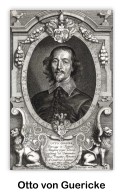 The Magdeburg hemispheres are a pair of large copper hemispheres with mating rims. When the rims were sealed with grease and the air was pumped out, the sphere contained a vacuum and could not be pulled apart by teams of horses. The Magdeburg hemispheres were designed by German scientist and mayor of Magdeburg, Otto von Guericke in 1656 to demonstrate the air pump which he had invented, and the concept of atmospheric pressure. The first artificial vacuum had been produced a few years earlier by Evangelista Torricelli, and had inspired von Guericke to design the world's first vacuum pump, which consisted of a piston and cylinder with one-way flap valves. The hemispheres became popular in physics lectures as an illustration of the power of air pressure, and are still used in education. The original hemispheres are preserved in the Deutsches Museum in Munich. [2,10]
The Magdeburg hemispheres are a pair of large copper hemispheres with mating rims. When the rims were sealed with grease and the air was pumped out, the sphere contained a vacuum and could not be pulled apart by teams of horses. The Magdeburg hemispheres were designed by German scientist and mayor of Magdeburg, Otto von Guericke in 1656 to demonstrate the air pump which he had invented, and the concept of atmospheric pressure. The first artificial vacuum had been produced a few years earlier by Evangelista Torricelli, and had inspired von Guericke to design the world's first vacuum pump, which consisted of a piston and cylinder with one-way flap valves. The hemispheres became popular in physics lectures as an illustration of the power of air pressure, and are still used in education. The original hemispheres are preserved in the Deutsches Museum in Munich. [2,10]
1660-1669
- No data
1670-1679
1670 (Brescia, Italy) — Jesuit Francesco Lana de Terzi describes in his treatise Prodomo, a vacuum-airship-project.
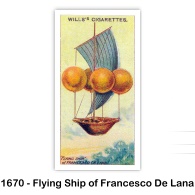 It is considered the first realistic, technical plan for an airship. However, de Terzi wrote: "God will never allow that such a machine be built … because everybody realizes that no city would be safe from raids." He was an Italian Jesuit, mathematician, naturalist and aeronautics pioneer. Having been professor of physics and mathematics at Brescia, he first sketched the concept for a vacuum airship and has been referred to as the Father of Aeronautics for his pioneering efforts, turning the aeronautics field into a science by establishing “a theory of aerial navigation verified by mathematical accuracy.” He also developed the idea that developed into Braille. [2,3,11]
It is considered the first realistic, technical plan for an airship. However, de Terzi wrote: "God will never allow that such a machine be built … because everybody realizes that no city would be safe from raids." He was an Italian Jesuit, mathematician, naturalist and aeronautics pioneer. Having been professor of physics and mathematics at Brescia, he first sketched the concept for a vacuum airship and has been referred to as the Father of Aeronautics for his pioneering efforts, turning the aeronautics field into a science by establishing “a theory of aerial navigation verified by mathematical accuracy.” He also developed the idea that developed into Braille. [2,3,11]1678 (Sablé, France) — Would-be pilot leaps from cottage garret — Local locksmith Monsieur Besnier has startled his neighbors by performing a successful flying experiment with a pair of wood-and-taffeta wings strapped to his back.
 He leapt from a cottage garret and soared over an adjoining building before coming to rest.
He leapt from a cottage garret and soared over an adjoining building before coming to rest.Besnier's “wings” consist of two wooden shafts which the pilot wears down each side of his body, attached to his arms and legs. In flight, he moves his limbs as if he were walking on the ground - swinging his right arm when he moves his left leg, and vice versa - so that when he pulls down with his right hand on the right wing, he pulls with his left leg on the left wing. The poles are fitted with hinged shutters at their ends, and these open flat on the down stroke and fold up edge-to-edge on the up stroke, to avoid drag. Besnier has sold a pair of these wings to a passing entertainer and is working on a second set. [1,2,3]
1680-1689
1680 (Rome, Italy) — Italian physicist Giovanni Alfonso Borelli, the father of biomechanics, claims in his treatise De Motu Animalium (On the Movements of Living Things) that human beings do not have the muscles needed to achieve lifting flight with wings without mechanical help. Borelli has used a laws of dynamics and statics to assess muscular capabilities and is applied mechanical principles to the movement of various animal bodies. People are made to walk, not to fly, concludes this professor of mathematics, physics and physiology. [1,2,12]
1687 (England) — Isaac Newton published the Philosophiae Naturalis Principia Mathematica, basics of classical physics. In this book he presented the theoretical derivation of the essence of the drag equation.
Sir Isaac Newton (1642-1727) was an English physicist, mathematician, astronomer, natural philosopher, alchemist, and theologian. His monograph Philosophiæ Naturalis Principia Mathematica, published in 1687, lays the foundations for most of classical mechanics. In this work, Newton described universal gravitation and the three laws of motion, which dominated the scientific view of the physical universe for the next three centuries. Newton showed that the motions of objects on Earth and of celestial bodies are governed by the same set of natural laws, by demonstrating the consistency between Kepler's laws of planetary motion and his theory of gravitation, thus removing the last doubts about heliocentrism and advancing the Scientific Revolution. The Principia is generally considered to be one of the most important scientific books ever written.
Newton built the first practical reflecting telescope and developed a theory of color based on the observation that a prism decomposes white light into the many colors that form the visible spectrum. He also formulated an empirical law of cooling and studied the speed of sound.
In mathematics, Newton shares the credit with Gottfried Leibniz for the development of differential and integral calculus. He also demonstrated the generalised binomial theorem, developed Newton's method for approximating the roots of a function, and contributed to the study of power series.
Newton was also highly religious. He was an unorthodox Christian, and wrote more on Biblical hermeneutics and occult studies than on science and mathematics, the subjects he is mainly associated with. Newton secretly rejected Trinitarianism, fearing to be accused of refusing holy orders. [1,13,14]
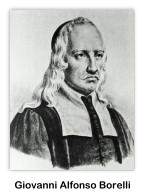
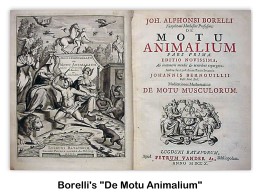
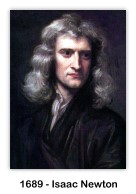
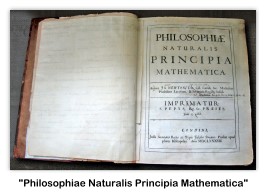
1690-1699
- No data
Works Cited
- Gunston, Bill, et al. Chronicle of Aviation. Liberty, Missouri: JL Publishing Inc., 1992.
- Wikipedia, Timeline of Aviation Before the 18th Century
- Shupek, John (photos and card images), The Skytamer Archive. Skytamer Images, Whittier, CA
- Wikipedia, Hezârfen Ahmed Çelebi
- anonymous, Addictive Istanbul (website)
- Wikipedia, Lagari Hagen Çelebi
- Wikipedia, John Wilkins
- Wikipedia, The Man in the Moone
- Wikipedia, Evangelista Torricelli
- Wikipedia, Otto von Guericke
- Wikipedia, Francesco Lana de Terzi
- Wikipedia, Giovanni Alfonso Borelli
- Wikipedia, Isaac Newton
- Wikipedia, Philosophiæ Naturalis Principia Mathematica
Copyright © 2013 Skytamer Images, Whittier, California
All rights reserved